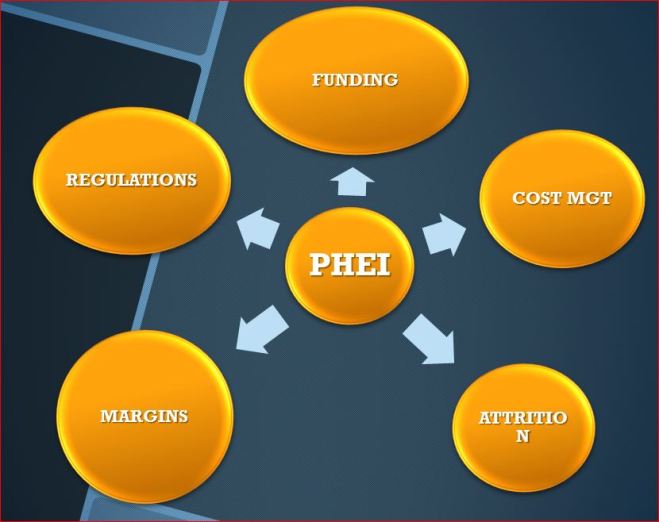How to analyse Education Industry in Malaysia?
by Dominic Shum March 2016.
The Education industry especially that of higher education is a thriving one in Malaysia with hundreds of players on top of government funded ones. This includes listed entities, foreign branch campuses, local degree granting institutions and colleges running franchised degrees and diplomas. While there are many successful colleges like Brickfields Asis College who prides themselves as the best brand in Legal Education, or SEGI University with their majestic campus, many other colleges are not doing well. This is due mostly to mismanagement and since most of the factors affecting the success of any Private Higher Education Institutes (PHEIs) are the same. Shum(2016) postulated the framework to understand and to analyse the strategic factors that PHEIs need to focus on. This is shown in the diagram below.

The Challenges for PHEIs in Malaysia by (c) Dominic Shum 2016
Funding - In this framework funding refers to student funding. A lot of growth in the first 15 years was driven by easy money in the form of PTPTN loans/grants, MARA loans/Scholarships, Bank Loans, EPF withdrawals. As we now know MARA and PTPTN funds have at some time another became a very challenging factor.
Cost - The industry is also concerned with the rapid rise of academic salaries and other cost which eats info the profit margin of the PHEIs.
Profit Margins- Gross Margins in the industry must be managed well within certain range as competition is tough and prices are difficult to increase. This is also critical because cost (fixed cost especially) will rise steadily.
Student attrition- Student Attrition is also an alarming challenge which must be handled well. For example a loss of student in the first year of study means a lost of two years fees down the road.
Regulations- Lastly, being caught out by changes in the government regulation could be a disaster for PHEIs not unlike the situation Masterskills found themselves in.
In order to thrive, PHEI must constantly monitor the environment and conduct strategic analysis of the industry when necessary to come out with new strategies to even survive let along succeed. The five factors or challenges must be taken care of and monitored closely. the demand side of the industry is always there and is projected to grow but PHEIs must look within to find the best answer as to how such demand will be made and be met profitably.
References:
Guidebook-Getting Started, PHEI Business in Malaysia (2009), retrieved February, 2.2016 fromhttp://www.mampu.gov.my/documents/10228/25989/21-PHEI_Guidebook.pdf/bb929c17-91e5-4029-8b28-55bce6ff52df
- Shum, Dominic (2016), Strategic Look at Private Higher Education in Malaysia, accessed 9 April 2016 from https://drcservices.me/2016/03/09/196/